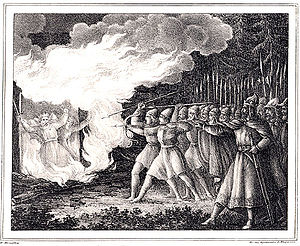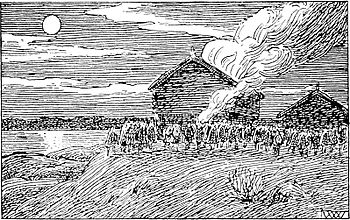Arson in medieval Scandinavia

Arson in medieval
In Iceland
Under
Now they took fire, and made a great pile before the doors. […] Then the women threw whey on the fire, and quenched it as fast as they lit it. Some, too, brought water, or slops. Then Kol Thorstein's son said to Flosi : "A plan comes into my mind; I have seen a loft over the hall among the crosstrees, and we will put the fire in there, and light it with the
vetch-stack that stands just above the house."Then they took the vetch-stack and set fire to it, and they who were inside were not aware of it till the whole hall was ablaze over their heads. Then Flosi and his men made a great pile before each of the doors, and then the women folk who were inside began to weep and to wail. […]
Now the whole house began to blaze. Then Njal went to the door and said : "Is Flosi so near that he can hear my voice?"
Flosi said that he could hear it.
"Wilt thou," said Njal, "take an atonement from my sons, or allow any men to go out?"
"I will not," answers Flosi, "take any atonement from thy sons, and now our dealings shall come to an end once for all, and I will not stir from this spot till they are all dead; but I will allow the women and children and house-carles to go out."
— The Story of Burnt Njal[5]
Another instance of quickfire is told in the
The
In both
Sweden
In Sweden, at least three kings are told as having used quickfire as a way to kill their opponents. The semi-legendary king
According to the Orkneyinga saga and the Saga of Hervör and Heithrek, the exiled Swedish king Inge the Elder retook the Swedish throne by using quickfire against his pagan opponent Blot-Sweyn. This happened c. 1087 :
King Ingi set off with his retinue and some of his followers, thought it was but as small force. He then rode eastwards by Småland and into Östergötland and then into Sweden. He rode both day and night, and came upon Svein suddenly in the early morning. They caught him in his house and set it on fire and burned the band of men who were within. There was a baron called Thjof who was burnt inside. He had been previously in the retinue of Svein the Sacrificer. Svein himself left the house, but was slain immediately. Thus Ingi once more received the Kingdom of Sweden; and he reestablished Christianity and ruled the Kingdom till the end of his life, when he died in his bed. — The Saga of Hervör and Heithrek[11]
The Altuna Runestone[12] in Sweden also tells that a father and a son were burnt to death inside their home :
Vifast, Folkad, kuþar had this stone raised in memory of their father Holmfast [and of their brother] Arnfast. Father and son were both burnt in. And Balle and Frösten, Livsten's retainers [carved].[13]
Norway
In the
After this battle (A.D. 868) King Harald subdued South More; but Vemund, King Audbjorn's brother, still had Firdafylke. It was now late in harvest, and King Harald's men gave him the counsel not to proceed south-wards round Stad. Then King Harald set Earl Ragnvald over South and North More and also Raumsdal, and he had many people about him. King Harald returned to Throndhjem. The same winter (A.D. 869) Ragnvald went over Eid, and southwards to the Fjord district. There he heard news of King Vemund, and came by night to a place called Naustdal, where King Vemund was living in guest-quarters. Earl Ragnvald surrounded the house in which they were quartered, and burnt the king in it, together with ninety men. Then came Berdlukare to Earl Ragnvald with a complete armed long-ship, and they both returned to More. The earl took all the ships Vemund had, and all the goods he could get hold of. — Harald Harfarger's Saga, chapter 12.[2]
In contrast with Icelandic accounts of quickfire in the

Soon after Gregorius heard that Hakon and his men were at a farm called Saurby, which lies up beside the forest. Gregorius hastened there; came in the night; and supposing that King Hakon and Sigurd would be in the largest of the houses, set fire to the buildings there. But Hakon and his men were in the smaller house, and came forth, seeing the fire, to help their people. There Munan fell, a son of Ale Uskeynd, a brother of King Sigurd Hakon's father. Gregorius and his men killed him, because he was helping those whom they were burning within the house. Some escaped, but many were killed. […]
King Hakon and Sigurd escaped, but many of their people were killed. Thereafter Gregorius returned home to Konungahella. Soon after King Hakon and Sigurd went to Haldor Brynjolfson's farm of Vettaland, set fire to the house, and burnt it. Haldor went out, and was cut down instantly with his house-men; and in all there were about twenty men killed. Sigrid, Haldor's wife, was a sister of Gregorius, and they allowed her to escape into the forest in her night-shift only; but they took with them Amunde, who was a son of Gyrd Amundason and of Gyrid Dag's daughter, and a sister's son of Gregorius, and who was then a boy about five years old.
— Saga of Hakon Herdebreid (Hakon the Broad-Shouldered), chapter 13.[2]
Popular culture
- In Ragnar Lothbrokmurders his "former" enemy Jarl Borg's warriors by burning their couters.
- In Saxon Stories, and its TV adaptation, The Last Kingdom, the house of the adoptive father of the protagonist Uhtred of Bebbanburg, Earl Ragnar, burns in similar fashion.
See also
References
- ^ a b Njal's Saga § 129.
- ^ a b c d Sturluson, Snorri (1844). Heimskringla. Laing, Samuel (trans.). London.
- Eirikr Magnusson(Bernard Quaritch, London, 1892) uses the translation "quickfire".
- ^ Njal's Saga § 77.
- ^ Anonymous (1861). "128". The Story of Burnt Njal. George W. DaSent (trans.).
- ^ Eyrbyggja Saga § 31.
- ISBN 9780559070310.
- ISBN 9781853267857.
- ^ Lönnroth, Lars (1976). Njáls saga: a critical introduction. Berkeley: University of California Press.
there are also references to the fire.
- ^ Sturluson, Snorri (1844). Heimskringla. Laing, Samuel (trans.). London., Ynglinga Saga Archived July 22, 2011, at the Wayback Machine, chapter 40
- ^ The Saga of Hervör and Heithrek, in Stories and Ballads of the Far Past, translated from the Norse (Icelandic and Faroese), by N. Kershaw.Cambridge at the University Press, 1921. Archived 2006-12-27 at the Wayback Machine
- ISBN 91-7844-067-Xp. 150
- ISBN 0-19-820643-7.
Bibliography
- Cook, Robert, trans. Njal's Saga. Penguin Classics, 2002.
- Lang, Samuel, trans. "Ynglinga Saga, or The Story of the Yngling Family from Odin to Halfdan the Black". Heimskringla. London, 1844; with corrections and edits by Douglas B. Killings; as published by northvegr.org, 2007.
- Palsson, Hermann and Paul Edwards, trans. Eyrbyggja Saga. Penguin Classics, 1989.
